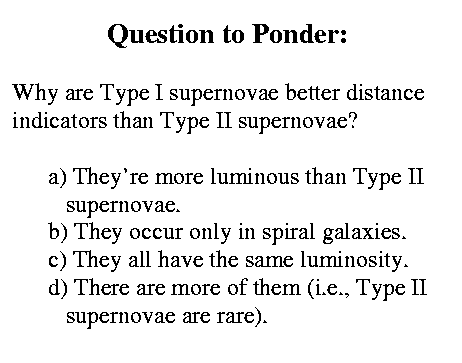|
|
She came from Planet Claire I knew she came from there She drove a Plymouth Satellite Faster than the speed of light B-52's, She Came from Planet Claire |
Assignments:Read Chapter 34, Sections 5-8 (pp. 575-581)Problem Set #7 due Tuesday 20 April, 5:00 pm
|

In Class:
Using the Hubble Law to map the universe
once you believe in the Hubble Law, you can turn it around
now measure velocity and infer distance
speed = (Hubble constant) x distance
somewhat dangerous practice
- really need to belive that the universe is expanding
and that the expansion is such that a Hubble Law
would hold
- you will test (or already have tested)
this issue in lab
- ALSO, need to know H very well
- that's pretty tough
In practice: measure the REDSHIFT == z == delta_lambda/lambda
- change in wavelength
i.e., what you observe compared to what you
"should" observe if there were no
speed difference between emitter and observer
for speeds small compared to the speed of light,
delta_lambda/lambda = delta_nu/nu = v/c
(i.e, we're back to the same of Doppler relation)
(this is the case for Problem #1 of PS#7)
However, some redshifts have values greater than 1
ie.., delta_lamba/llambda > 1
--> implies that v/c > 1
-- speeds faster than the speed of light????
No. Einstein's Theory of Special Relativity is quite clear on this score
- nothing moves faster than light
- even more freaky,
- speed of light is the same in all velocity frames
- speed limit of the universe
- doesn't look different to two observers
travelling at different speeds
--------
Consider an example:
You're driving down the highway at 60 mph
You shoot an arrow from your car
- from your viewpoint (in the car),
the arrow moves forward at a speed of 90 mph
How fast does the arrow appear to move to someone standing
next to the road?
60 mph + 90 mph = 150 mph, right?
When speeds get close to the speed of light, this kind of velocity addition
is no longer correct
Consider a car moving at 60% of the speed of light
Shoot an arrow from the car
- from your viewpoint (in the car),
the arrow moves forward at a speed of
90% of the speed of light
How fast does the arrow appear to move to someone standing
next to the road?
NOT 60% + 90% = 150% of the speed of light
- this would break the cosmic speed limit
(actually appears to move at 97%)
----------------
this idea gets realy freaky when you consider light itself
- instead of an arrow, shoot a light beam out fromm your car
- it appears to move at the speed of light
away from you
- but it also appears to move at the same speed
for an observer on the side of the road!!
- light moves at the speed of light, regardless of your speed
- how can this happen?
it has to do with the fact that observers moving with
respect to one another measure time in different ways.
-- very freaky
-- nonintuitive
This wrecks havoc with our intuitive concept of the Doppler shift,
which is based on the idea that if an emitter is moving toward
us, the wavefronts of the emission will be squished together
because each wavefront is emitted from a point slightly closer to
us than the last.
for speeds small compared tothe speed of light, this idea is
still just fine, and produces perfectly accurate results.
it's just that for very high speeds, our simple Doppler formula is incorrect
--> at high speeds, the relationship between speed and redshift is
more complicated
delta_lambda/lambda = sqrt((1+v/c)/(1-v/c)) - 1
for speeds greater than about 0.1c (i.e, 10% of the speed of light)
you should use the formal relativistic formula
Now large redshifts don't imply speeds greater than the speed of light
------------------
consider z = 2 (spectral lines shifted by twice their wavelength)
i.e, 656nm --> 1968nm
2 = sqrt((1+v/c)/(1-v/c)) - 1
3 = sqrt((1+v/c)/(1-v/c))
square both sides
9 = (1+v/c)/(1-v/c)
multiply by 1-v/c
9 - 9v/c = 1 + v/c
add 9v/c to both sides
9 = 1 + 10v/c
8 = 10v/c
0.8 = v/c --> speed is 80% of the speed of light
-------------------
To map out the universe:
1) measure redshifts of lots of galaxies
2) calculate speed from redshift
3) calculate distance from Hubble Law
4) make a map of direction vs. distance
lots of structures
- bubbles and voids
- some structures more than 10 Mpc long
- voids at least that wide across
How do you form such huge things?
Problems with using the Hubble law to determine distances
- peculiar motions
- consider two gax orbiting each other
- turns into a distance difference
- now consider a bucnh of galaxies orbiting in a cluster
- each galaxy's "peculiar" motion will put it at a different
distance
- finger of god structure
|
![]()